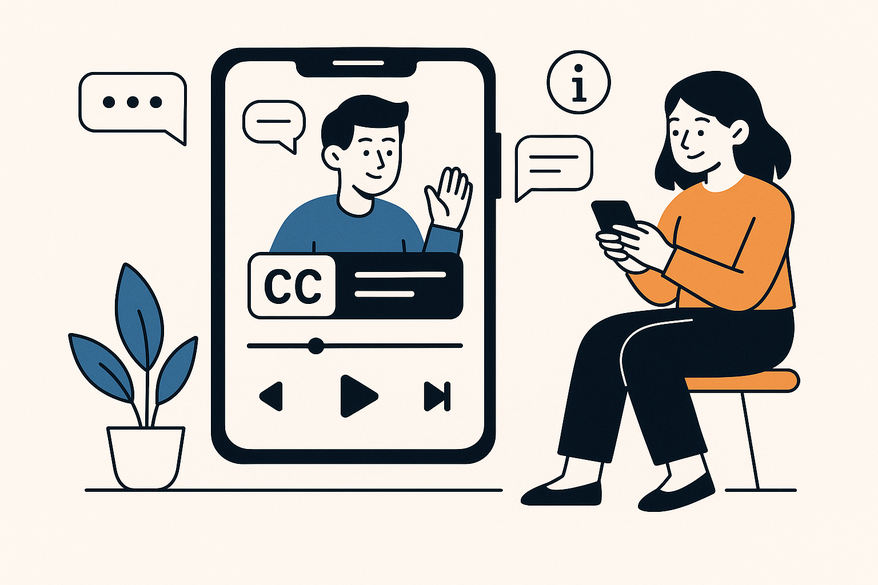Closed Captions Chat Story Video: A Complete Guide to Accessible, Engaging Storytelling
Explore how closed captions in chat story videos enhance storytelling, accessibility, and audience engagement. Learn best practices for inclusive video content.

Estimated reading time: 10 minutes
Key Takeaways
- Accessibility First: Closed captions deliver time-synced text for all audio elements, making stories inclusive for deaf and hard-of-hearing viewers.
- Engaging Format: Chat story videos mimic messaging apps for snackable, mobile-first narrative experiences.
- Best Practices: Sync captions to chat bubbles, annotate non-speech sounds, and maintain readability with concise lines and high contrast.
- Tools & Workflows: From automatic generators (YouTube Studio, Kapwing) to professional services (3Play Media), choose the right solution for your project.
- Impact & Reach: Captions boost engagement, support SEO, ensure legal compliance, and enable multilingual distribution.
- Future Trends: Look out for AI-powered accuracy, interactive chat narratives, AR/VR overlays, and sign-language avatars.
Table of Contents
- Understanding Closed Captions
- Chat Story Videos Explained
- Integration of Closed Captions in Chat Story Videos
- Benefits to Creators and Viewers
- Future Trends and Innovations
- Conclusion
- FAQ
Section 1: Understanding Closed Captions
Keyword: closed captions
What Are Closed Captions?
- Time-synchronized text versions of a video’s entire audio track, including dialogue, sound effects, speaker IDs, and auditory cues.
- Different from subtitles, which often omit non-speech elements like “[door creaks]” or “[laughter].”
Legal Requirements and Benefits
- Mandatory in many regions under laws such as the ADA, WCAG, and FCC rules.
- Improves searchability and SEO through indexable text, while enhancing viewer engagement and retention.
Caption Creation Methods
- Respeaking: Live captioner repeats audio into voice-to-text software for near-real-time output.
- Stenography: Shorthand machines deliver rapid captions in live broadcasts and court reporting.
- Manual Transcription & Syncing: Editors transcribe pre-recorded content and align text to timestamps.
- File Formats: SRT and VTT are common and import easily into editors like Adobe Premiere Pro and Final Cut Pro.
Sources for Section 1:
3Play Media: What Is Closed Captioning
Wikipedia: Closed Captioning
3Play Media: Closed Captioning Topics
Dallas College Accessibility Guidelines
AI-Media: Closed Captions vs Subtitles
Section 2: Chat Story Videos Explained
Keyword: chat story video
What Is a Chat Story Video?
- Visual narratives that mimic messaging apps, with chat bubbles, typing indicators, and embedded media.
- Dialogue unfolds like real text conversations, immersing the viewer in the story.
Why They Resonate
- Mobile-first design: optimized for vertical screens and one-handed scrolling.
- Snackable content: short, quick-to-consume segments ideal for modern attention spans.
- Relatable style: mirrors everyday texting habits of younger audiences.
Top Platforms
- Instagram Stories & Reels
- Snapchat Stories
- TikTok
- YouTube Shorts
Use Cases
- Fiction genres like horror, romance, and sci-fi chat dramas.
- True crime retellings with suspenseful text pacing.
- Tutorials and recipes in a conversational chat format.
- Brand marketing that feels personal and text-based.
- News updates delivered as bite-sized chat exchanges.
Section 3: Integration of Closed Captions in Chat Story Videos
Keywords: closed captions, chat story video, captioning tools, accessibility best practices
Process & Technology
- Transcribe all chat dialogue and background audio; annotate non-speech sounds (e.g., “[phone buzzes]”).
- Sync captions to the exact timestamps of chat bubble appearances for smooth reading.
- Embed captions using video editors like Adobe Premiere Pro or online tools.
Challenges & Best Practices
- UI Overlap: Position captions above or below bubbles to avoid hiding text; see chat video editing tips.
- Tone & Emojis: Replace emojis with descriptors (e.g., “[laughing emoji]”) or plain-text equivalents.
- Readability: Keep captions to 1–2 lines, use high-contrast fonts, and maintain consistent timing.
Tools & Software Recommendations
Automatic Generators:
- YouTube Studio (auto-generate & edit)
- Kapwing (browser-based editor)
- Rev.com (AI + human review)
Manual/Advanced Editors:
- Amara (crowd-sourced)
- 3Play Media (professional services)
- Aegisub (open-source)
In-App Solutions:
- TikTok’s built-in caption tool
- Instagram’s “Captions” sticker
For step-by-step guidance on adding captions to fake chat videos, check our tutorial.
Many creators turn to tools like Vidulk - Fake Text Message Story App for an all-in-one solution.
Sources for Section 3:
AI-Media: Closed Captions vs Subtitles
Section 4: Benefits to Creators and Viewers
Keywords: closed captions, chat story video, viewer engagement, SEO
Enhanced Viewer Engagement & Comprehension
- Captions boost retention, especially when audio is rapid, unclear, or muted.
- Viewers in noisy or quiet environments can follow along without sound.
Accessibility, SEO & Global Reach
- Legal compliance widens your audience to include deaf and hard-of-hearing viewers.
- Search engines index caption text, improving discoverability and rankings.
- SRT/VTT files enable easy translation for multilingual distribution.
Real-World Examples
- Brand X on Instagram saw a 25% increase in watch time for autoplay videos after adding captions.
- News Outlet Y used chat story videos with captions to engage non-English speakers in regional campaigns.
Sources for Section 4:
3Play Media: Closed Captioning Topics
Dallas College Accessibility Guidelines
AI-Media: Closed Captions vs Subtitles
Section 5: Future Trends and Innovations
Keywords: future of video captions, chat story video trends, AI captioning
- Interactive Chat Formats: Branching narratives and polls that adapt in real time.
- AI-Powered Captioning: Advanced speech-to-text engines with speaker separation and tone detection.
- AR/VR Integration: Immersive overlays with customizable captions in 3D space.
- Sign-Language Avatars & Audio Descriptions: On-screen interpreters and descriptive narration for low-vision viewers.
Conclusion
Closed captions in chat story videos merge accessibility with modern storytelling, helping you comply with legal standards while maximizing viewer engagement. Well-timed captions preserve immersion and serve all audiences—deaf or hearing, local or global. As a creator, choose the right tools, follow ADA/WCAG guidelines, and prioritize inclusivity to craft stories that are entertaining, relatable, and universally accessible.
Call to Action
Start adding closed captions to your next chat story video. Select a captioning tool, refer to legal guidelines, and make your storytelling inclusive for every viewer.
Sources for Conclusion:
Dallas College Accessibility Guidelines
3Play Media: Closed Captioning Topics
AI-Media: Closed Captions vs Subtitles
FAQ
-
Q: What is a closed captions chat story video?
A: It’s a short video that combines chat-style on-screen messaging with time-synced captions for all audio, ensuring full accessibility and engagement. -
Q: How do I add captions to my chat story video?
A: Transcribe dialogue and non-speech sounds, sync text to chat bubble timestamps, and embed captions using editors like Premiere Pro or online tools such as Kapwing. -
Q: Which tools offer the best captioning workflows?
A: Automatic tools include YouTube Studio and Rev.com; for professional services, consider 3Play Media, while in-app options exist on TikTok and Instagram. -
Q: Are captions legally required?
A: Many jurisdictions mandate captions under laws like the ADA and WCAG, so adding them ensures compliance and broadens audience reach. -
Q: What future innovations are coming to captions?
A: Expect AI-driven accuracy, interactive chat elements, AR/VR overlays, and sign-language avatars to further enhance accessibility.





